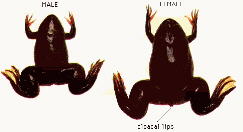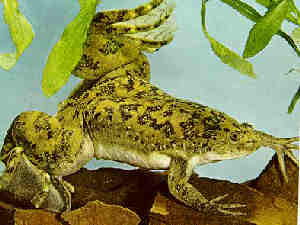Often these frogs are confused for their smaller cousin, the African Dwarf Frog.
How to tell the Clawed Frog from the Dwarf Frog.
Also, these guys need a really good cover so they don't go exploring outside their tank!
- Now I'm going to tell you a very sad story;
Several years ago, my sister got 2 Albino African Clawed Frogs. The pet store sold them as African Dwarf frogs (they look pretty similar when young...though I've never seen albino dwarf frogs).
Well, she thought they were really cool and named them Humpty and Dumpty). They were housed in a hexagon plastic tank full of water (the gallon and a half size) along with a huge goldfish. This setup would probably have been just fine for dwarf frogs, but the clawed frog is more likely to be "hoppity" and managed to jump through a small opening in the top (which I think was supposed to be for air filters and heaters etc.) and it hopped all the way out of her bedroom, all the way down the stairs, all the way to the living room, where it stuck itself to a window and dried up.
It was the saddest, most pathetic thing you ever saw ...so close to freedom and yet so far!
The next frogs my sister got were truly dwarf frogs and no such problems occured.
The moral of this story is, make sure that all openings are well sealed, either with a net or something so that they can't get out! I get mail all the time from people with stories like this!
-
Hi, My name is Chris. I have an African frog that I used to keep in a very cool aquarium that I have. It is a 60 Hex that is 4 feet tall and 12 inches wide(side to side). This take also has a stand and cap, each one being adding 1 foot the the height of the aquarium. I once discovered, to my dismay, that he had escaped one day. I searched all over my room and around my apartment. I couldn't find him. The next day, my room mate got home(who actually owns the frog, but keeps him in my tank since he has proven himself inept at being an aquarist) and I told him. We both looked around and he found the frog by the door to the patio. When I first saw the frog I was instantly reminded of the desciated, flattened frogs seen on the roadside after losing a fight with a car. We both were sure he was dead. I went ahead a put him in some water just to be sure, but when he just sank and didn't move, I took him out. I was morbidly curious about the frog so I took a close look at him. I was amazed at how much dust he had collected and how rubbery his skin had become. Then I was even more amazed to see his nostrils move. Here was this desicated little frog(about a year old) with rubberized skin, dust, hair, sunken in eyes and no discernible life signs, except his nostrils were moving! I quickly put him back in the bowl of water but drained it so that his nostrils were above water. Then I took a wet paper towel and very gently cleaned all the dust and stuff off of him. Within a few hours, he began moving(a little) and his eyes took on their normal shape again. In the next few days, some of his fingers, skin and webbing came off and we again were worried whether or not he could recover enough to eat and keep healing(he had been fed on guppies). Fortunately, I fed him some blood worms and I put 1 guppy into the bowl with him as he recooperated. After a few days, he ate the guppy and I knew he was going to be alright. About a month later he has regrown all his fingers, skin, and webbing. He has also not been given the opportunity to escape again. Hard to believe, but this little frog survived a six foot jump(narrowly missing the light) to the the floor and a 2 day safari into the dusty depths. I'm gonna try to get my roommate to rename him to Evil Kanevil.
Read more information on tank set-up in the Housing Your Pet Frog section.
(see the Frog Doctor for details on illness prevention.)
One visitor recommended Tetra's ReptoMin. "It contains all the vitamins and such, though I have found they prefer to have each stick broken into at least three pieces. I think this is a vital piece of info for your sheet. People may be taken aback at having to feed just shrimp or feeder fish as the cost can really get up there. ReptoMin can be gotten cheaply (especially if by mail order) and last a good long while. I use feeder fish only as a treat with ReptoMin as the only other food sorce. I have had my frogs a number of years (not one sickness to date) and had one successfull breeding, so it must be good food."
Another writes that "specially-formulated food for ACFs is available at xenopus express for only $3.00 a pound (much more cost-effective than 'Reptomin' -- $30+ per pound)."
- Many years ago I saw one of the Grow-a-Frog kits in an upscale toystore for the 1st time. Couldn't resist. So bought 2. Sent one to my nephew and kept one. He wasn't as lucky as I was. His tadpole came, began to metamorphose, but died before completing the process. Mine finished the process and still lives. It never occurred to me to note the year, for who would have thought he'd live so long! It was either 1980 or 1981, but no later. He's just fine and still sings when I clean his bowl. I've changed containers over the years to different shapes and slightly different sizes to offer some variety in his life. As far as I've been able to tell, he's never been sick a day in his life. He may be a she. Many dogs, cats, gerbils, rats, tropical fish, one snapping turtle, and one cockatiel have become members of our family. All lived full lives and went to pet heaven & received burial in our flower beds. Neighbors always fed our menagerie when we went on vacations, but as the years ticked away, they worried that our frog might die on "their watch." They were as relieved as we, each time we returned to find everything OK including our beloved frog.
I'm a science teacher, but think that has little to do with our frog's longevity. My daughters are both grown and on their own. I guess I should start thinking about who I should entrust him with in my will. I've always assumed he was an African Dwarf. We didn't name him for many years because we never expected him to live much longer. After a while, when visitors always exclaimed, "You mean that frog is still ALIVE?", we started calling him "Alive."
I sold my large house after 27 years of loving it & moved to a condo in a downtown historical district. Fortunately, the re-location didn't bother him a bit. That was 2 years ago, & he's just fine.
These frogs also are pretty fun to watch. They do a loop-de-loop dance in the water from the tank floor to the top of the water when they mate, usually preceeded by a lot of "clasping", where the male grabs onto the female as she swims around. (It looks a lot like "hugging" to me) Tadpoles hatch within two days.
 (Click picture to see it bigger)
(Click picture to see it bigger)Photo copyrights:
"CBC"
Reptiles & Amphibians: Care & Culture Carolina Biological Supply Company © 1993,
ISBN 0-89278-040-1
"NAS"
Amphibians: Guidelines for breeding, care and management of laboratory animals
National Academy of Sciences © 1974, ISBN 0-309-02212-X
 This picture was posted by some anonymous person to alt.pictures.binaries.animals.
This picture was posted by some anonymous person to alt.pictures.binaries.animals.